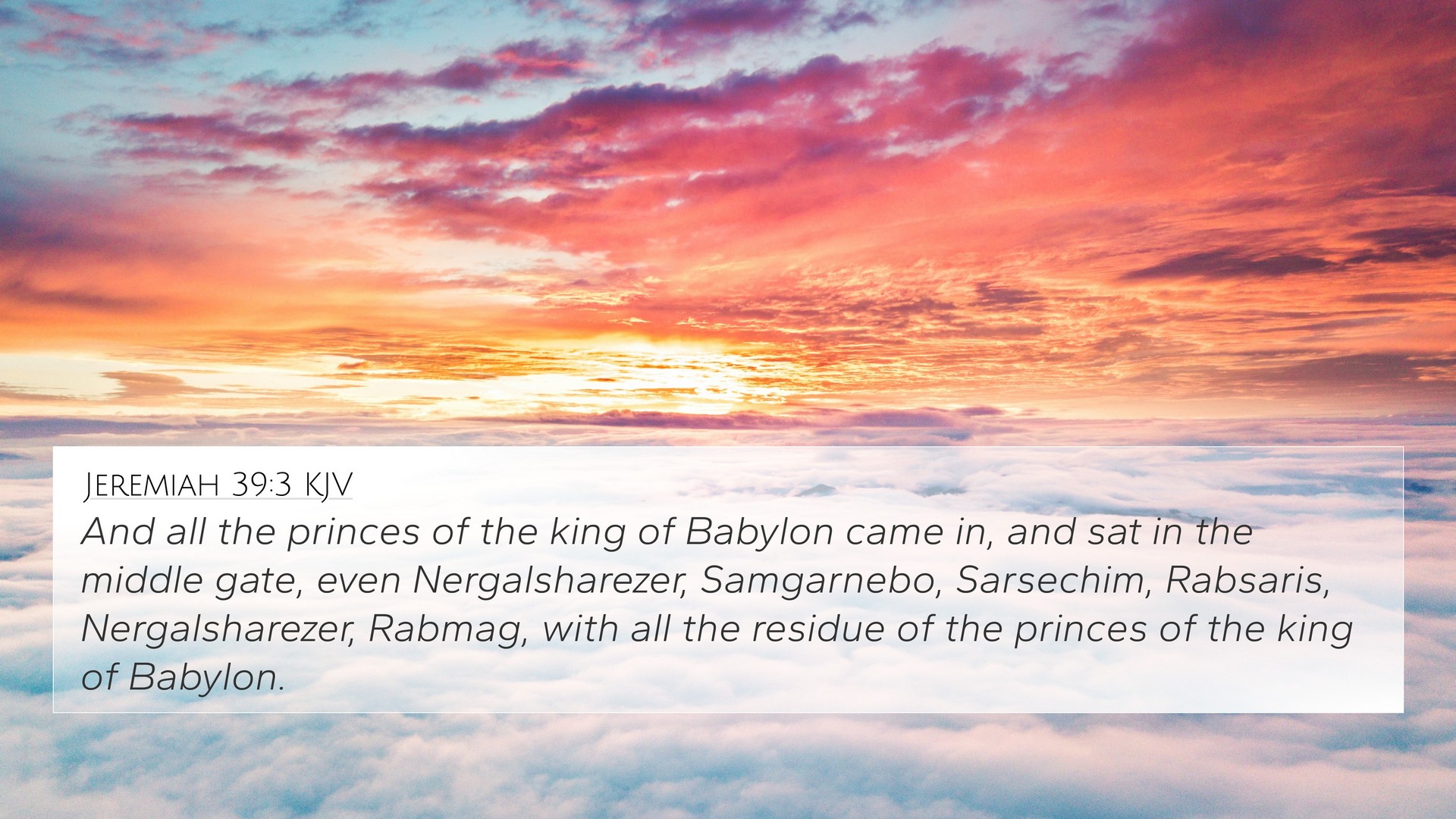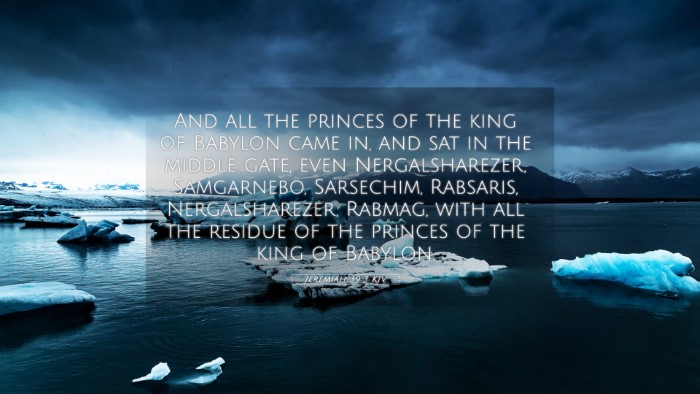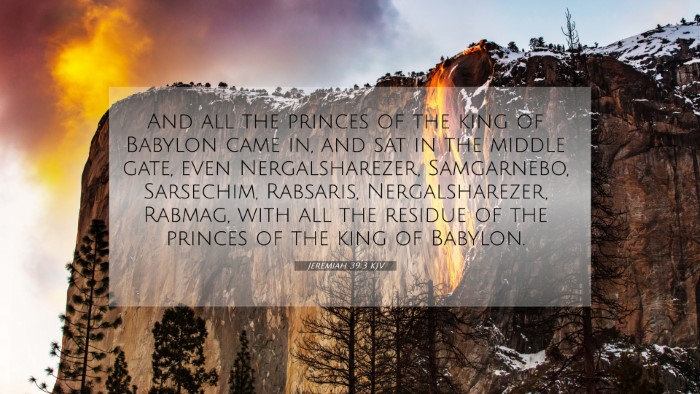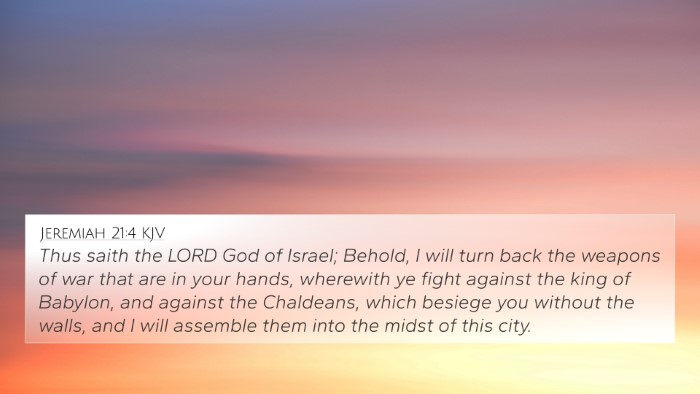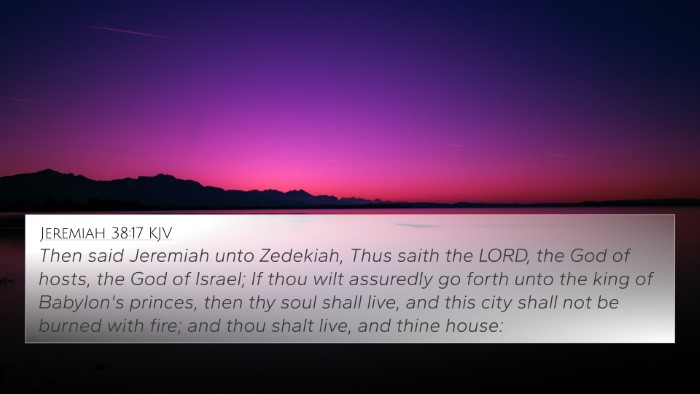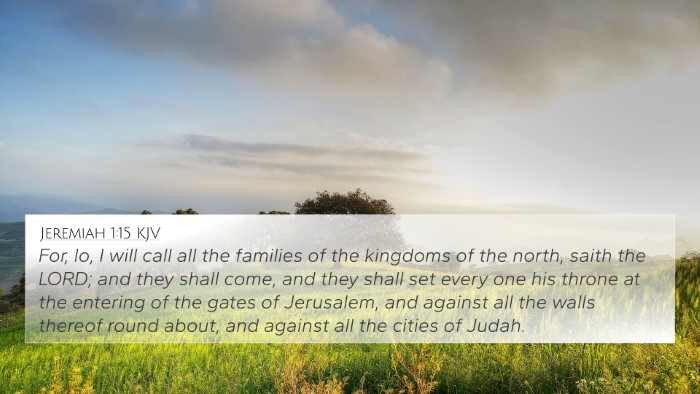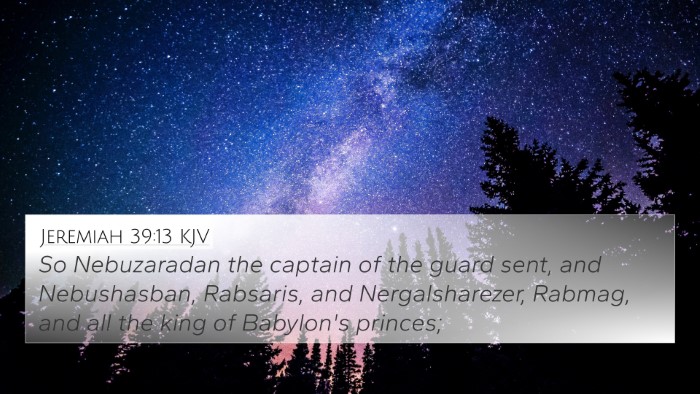Understanding Jeremiah 39:3
Jeremiah 39:3 reads: "Then all the princes of the king of Babylon came in, and sat in the middle gate, even Nergalsharezer, Samgarnebo, Sarsechim, Rabmag, with all the residue of the princes of the king of Babylon."
This verse captures a significant moment during the Babylonian siege of Jerusalem, marking a transition in the prophetic narrative of Jeremiah.
Context and Significance
Jeremiah prophesied during a tumultuous period for the people of Judah, culminating in the predicted conquest and destruction of Jerusalem. Verse 39:3 refers specifically to the Babylonian officials who played crucial roles during and after the siege, detailing their involvement and the new power dynamics in the aftermath of the fall.
Understanding this context is vital as it reflects the fulfillment of God's judgment upon Judah for its persistent disobedience.
Insights from Public Domain Commentaries
-
Matthew Henry:
In his commentary, Henry emphasizes the stark reality faced by Jerusalem's inhabitants upon the Babylonian victory. The gathering of Babylon’s princes signifies not only their power but also the dismantling of Judean leadership and the sealing of Jerusalem's fate.
-
Albert Barnes:
Barnes provides a detailed analysis of the names and roles of the Babylonian princes, underscoring their political and military strategies that led to the successful conquest of Jerusalem. He highlights how these actions correlate with the prophecies foretold by Jeremiah concerning the fate of the city and its rulers.
-
Adam Clarke:
Clarke discusses the authenticity of this historical account, noting its implications for understanding the broader narrative of exile and judgment. He draws connections between this event and previous warnings given by prophets, ultimately showcasing the fulfillment of divine prophecy through explicit historical events.
Bible Verse Cross-References
To further explore the themes present in Jeremiah 39:3, one may consider the following cross-references:
- 2 Kings 25:2-4: The account of Jerusalem's fall, noting the siege and the eventual breach of the city walls.
- Jeremiah 32:4: Prophecy regarding the capture of Jerusalem and king Zedekiah’s fate.
- Jeremiah 37:5: Insight into the military campaigns during the siege of Jerusalem.
- Isaiah 39:6-7: A prophecy concerning the Babylonian invasion and captivity.
- Ezekiel 12:13: Prophecy about the fate of Zedekiah and the exile of the people.
- Jeremiah 51:59-64: Prophecy against Babylon that connects to the fate of God’s people.
- Daniel 1:1: The beginning of the exile and the consequences for Jerusalem.
Thematic Bible Verse Connections
This section aims at linking Bible scriptures that help in understanding the overarching narrative found within Jeremiah 39:3:
-
Obedience vs. Judgment: The consistent theme throughout the prophetic literature, where disobedience leads to national calamities (see Deuteronomy 28 for blessings and curses).
-
The Role of Prophecy: This event is an affirmation of Jeremiah’s divine commission and the reality of God's word being fulfilled (refer to Jeremiah 1:10).
-
The Sovereignty of God: There’s a fundamental connection asserting that God reigns over the affairs of nations, utilizing even heathen powers for His divine purposes (see Proverbs 21:1).
Cross-Referencing Biblical Texts
For effective scriptural cross-referencing and deeper understanding, consider utilizing a bible concordance or a bible cross-reference guide. By cross-referencing passages such as 2 Chronicles 36:15-21 and Nehemiah 1:3, one can see the interconnectedness among Old Testament teachings that lead into the New Testament, particularly through themes of redemption and restoration.
Tools for Bible Cross-Referencing
To deepen your study of Jeremiah 39:3, several tools can assist in navigating and understanding the links between biblical texts. Consider exploring:
- Bible reference resources: These can provide comprehensive background and explanations.
- Bible chain references: Following themes or topics through different scripture passages.
- Cross-referencing Bible study methods: Involves thematic analysis or topical studies to uncover relationships between verses.
- Comparative study of Pauline epistles: Connections between Old Testament prophecies and New Testament fulfillments.
- Identifying connections between Old and New Testament: This provides a fuller understanding of themes across both sections of the Bible.
- Cross-referencing Psalms with New Testament teachings: Observing how the Psalms inform and support New Testament theology.
Final Thoughts
In conclusion, Jeremiah 39:3 serves as a powerful reminder of the reality of God’s judgment and the sovereignty exercised through historical moments of crisis. A thorough examination aided by scripture cross-referencing can enrich your understanding of divine themes, prophetic fulfillments, and the overall biblical narrative that weaves through history.
